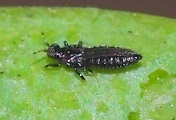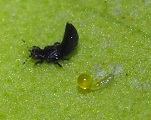| Home | Nature Weekly Index |
4 October 2020 | Redbanded Thrips | Selenothrips rubrocinctus |


 The Redbanded Thrips (Selenothrips rubrocinctus)
was first found on the leaf of a potted
Common Acacia (Acacia auriculiformis) at my balcony
area in November 2019. They were also known as Cocoa Thrips since they caused considerable damage to
cacao. Beside cacao, they were pest of many other plants as well.
Due to their tiny size, they were almost invisible to the naked eyes. The nymph and pupa are light yellow to
orange with the first three and last segments of the abdomen bright red.
The Redbanded Thrips (Selenothrips rubrocinctus)
was first found on the leaf of a potted
Common Acacia (Acacia auriculiformis) at my balcony
area in November 2019. They were also known as Cocoa Thrips since they caused considerable damage to
cacao. Beside cacao, they were pest of many other plants as well.
Due to their tiny size, they were almost invisible to the naked eyes. The nymph and pupa are light yellow to
orange with the first three and last segments of the abdomen bright red.
In September 2020, they appeared on the leaves of a potted Indonesian Bay Leaf (Syzygium polyanthum). The attack was quite severe as they could be found on every leaves and the plant looked very unhealthy.

 I happened to have another plant located at a separate location of the balcony which was in good health. Both
came to my pot as a result of spontaneous growth. To contrast the difference between infected and non-infected
leaves, I removed some leaves from the plants and placed them side by side. On the upper side of the leaves, the infected one had turned
slightly yellowish. The contrast at the underside of the leaves was even more distinct with the infected areas
turning brown and littered with tiny dark spots. The dark spots were the waste materials excreted by the thrips.
I happened to have another plant located at a separate location of the balcony which was in good health. Both
came to my pot as a result of spontaneous growth. To contrast the difference between infected and non-infected
leaves, I removed some leaves from the plants and placed them side by side. On the upper side of the leaves, the infected one had turned
slightly yellowish. The contrast at the underside of the leaves was even more distinct with the infected areas
turning brown and littered with tiny dark spots. The dark spots were the waste materials excreted by the thrips.
There was another thrips around my potted area. I shared about this slightly larger, black colour thrips in a post in June 2018. That thrips caused curling or folding of leaves that formed an enclosed breeding area. Besides my potted Malayan Banyan (Ficus microcarpa), this black thrips was also found on another fig tree, Common Red-stem Fig (Ficus variegata) which I had reported in March 2017. Compare to this black thrips, the Redbanded Thrips was even smaller in size.
After doing up this post, I decided to remove all the leaves from the infected Indonesian Bay Leaf. Hopefully, the new leaves that will re-appear in a few months’ time will be free of the thrips.
There was a nicely done YouTube video on the life cycle of thrips if you are interested to know more about these minuscule insects.